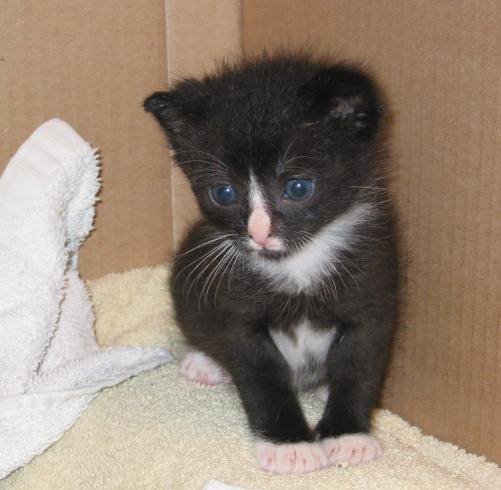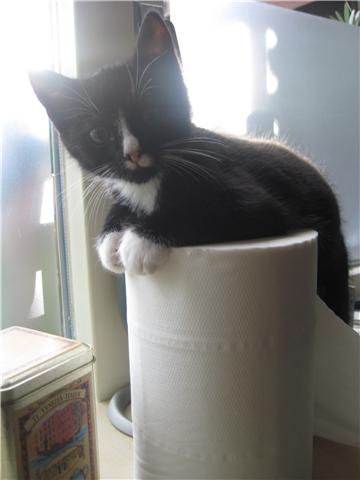0-3 weeks
Kittens are born with their eyes and ears closed, which means they are deaf and blind for about the first week of their lives. Around 7 to 10 days old, their eyes will open, but their vision will still be blurry. Kittens are born with blue eyes, and from three weeks onwards the color will change. Usually, around 8 weeks of age, they will have their permanent color. The kitten’s ears will open and stand up when they are 3 weeks old. From birth, kittens are able to make sounds to communicate with their mother. As they get older, they will become more vocal. Kittens are unable to eliminate themselves, and the mother cat will help them by stimulating them with her tongue. Kittens are born without visible teeth.

3-5 weeks
The first steps usually happen around 3 weeks of age, albeit wobbly. Slowly their balance will improve, and they will get interested in exploring their surroundings. Around 4 weeks of age, kittens will be stable enough to start using the litter box, which they will usually do instinctively. The first teeth will also come in around this time. At this point, their sense of hearing is fully developed.

6-8 weeks
Around this time you can start socializing the kitten. Introduce them slowly, in a positive way, to different people, kids, and other pets. Let them experience new smells, sights, and experiences, in a controlled manner. It’s also time for the first round of core vaccinations. When socializing, always keep in mind that the kitten isn’t vaccinated yet and precautions should be taken. Do not let your kitten outside. When the kittens are 6 weeks of age, they can be introduced to solid food. The mother cat should also still be given the option to feed the kittens her milk. Kittens should have all their baby teeth by 8 weeks of age.

9-12 weeks
Even though kittens can be introduced to solid foods around 6 weeks of age, the natural weaning process isn’t completed until around 9 to 12 weeks. Once the kitten is fully weaned, give them several small meals a day. Start with 4 meals a day until 3 months old. After 3 months, you can give them three meals. At six months of age, you can reduce to two meals a day.
These first few weeks of a kitten’s life are extremely important. They learn life skills from their mother and siblings like hunting, using a litter box, and cat communication. Studies show this continues well into week 10 till 12. So to give a kitten the best chance of becoming a well-adjusted cat, it should be prevented separating them before 10-12 weeks of age. Around 10-12 weeks of age, the kittens should also receive the next round of core vaccinations.
3-6 months
The kitten’s baby teeth will start falling out and will be replaced by their adult teeth. Around 6 months of age, this process should be completed. In some cases, adult teeth will grow either behind or in front of the baby teeth. If the baby teeth don’t come out on their own, they might have to be removed by a veterinarian. During this period, kittens will start testing their physical limits. They will start trying out how the world around them works by taking things in their mouth, and testing responses of people and other animals they approach. Make sure that your house is kitten proofed. For some kittens, sexual maturity will come as early as 5 to 6 months of age, so keep this in mind if you are having unneutered cats at home. At 14-16 weeks of age, the kittens need to get their next round of core vaccinations.

6 months to 1 year
At 6 months of age, the kitten will start to look more like a mini adult cat than a kitten. Usually, they will look a bit disproportionate with long legs and a long torso. During this period most kittens will reach sexual maturity. Male cats may start spraying, and female cats will go into heat. During this period, kittens will behave like teenagers. Once a kitten reaches the age of 1 year old, they are considered an adult cat, and in most cases are full-grown at this point.

The first year of a kitten
Will have passed before you know it. These tiny little creatures develop at a rapid pace from tiny little balls of fur to full grown cats. The choices we make as pet owners will partially determine if our kittens will grow up to be well-adjusted adults. By providing knowledge about kitten development, we hope to improve the welfare of pet cats and to inform pet owners about the choices they can make when it comes to caring for their kitten. We at Paw Pals would love to help if you are in need of pet sitting services for your cat, or if you would like to know more about relocation possibilities for your cat. Feel free to contact us for any information. We will be happy to help.

